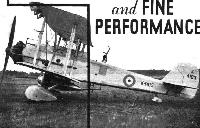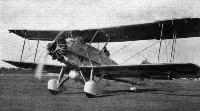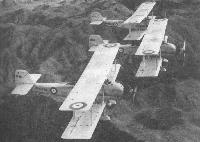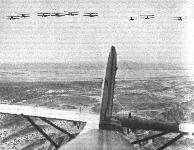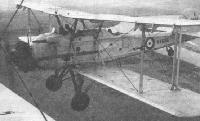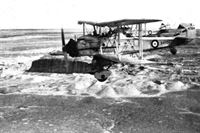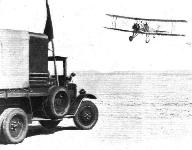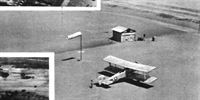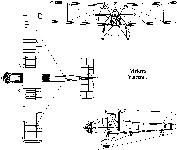
Варианты
- Vickers - Vildebeest / Type 132 - 1928 - Великобритания
- Vickers - Vincent / Type 266 - 1932 - Великобритания
Vincent / Type 266
Многоцелевой самолет взаимодействия с сухопутными войсками. Цельнометаллический одномоторный биплан с неубирающимся шасси (колеса в обтекателях). Являлся модификацией бомбардировщика-торпедоносца "Уайлдбист". Спроектирован в КБ фирмы "Виккерс авиэйшн" под руководством Р. Пирсона.
Двигатель "Пегасус" ПМЗ. Экипаж самолета -3 чел. Вооружение 2x7,69, бомбы до 454 кг.
Опытный образец "Винсента", переделанный из "Уайлдбиста" I, совершил первый полет 21 декабря 1932 г. Серийное производство на заводе "Виккерс" в Уэйбридже началось в июле 1934 г. Серийные машины основывались на планере самолета "Уайлдбист" II. Всего собрали 197 экз. Производство закончилось в октябре 1936 г.
Самолет поступил на вооружение английской авиации в колониях в декабре 1934 г. "Винсенты" дислоцировались в Адене, Египте и Судане, позднее в Ираке и Кении. В июле 1939 г. эти машины были закуплены новозеландскими ВВС.
В сентябре 1939 г. этот тип ближнего разведчика являлся одним из основных на Ближнем Востоке, но с 1940 г. их начали переводить во вспомогательные подразделения. Тем не менее, "Винсент" активно применялся в войне с итальянцами в Эритрее и Сомали в 1940-41 гг. 12 июня 1940 г. они нанесли первый бомбовый удар по итальянскому аэродрому в Эритрее. Их также использовали для связи с эфиопскими партизанами. При отходе итальянских войск из Керена "винсенты" действовали как штурмовики, атакуя колонны мелкими бомбами и пулеметным огнем. В Ираке эти бипланы использовались авиагруппой "Хаббания" при подавлении мятежа Рашида Али в мае 1941 г. При вступлении английских войск в Иран "винсенты" вели разведку на направлениях продвижения войск. До ноября 1942 г. эти самолеты патрулировали Оманский залив. Им удалось повредить итальянскую подводную лодку, которая была вынуждена сдаться. Позднее "винсенты" служили как учебные и связные.
Новозеландские "винсенты" обеспечивали патрулирование побережья и поиск подводных лодок на островах Фиджи до ноября 1942 г. В Новой Зеландии старые бипланы сняли с вооружения в мае 1943 г., в британских ВВС - в 1944 г.
"Винсент" I||
Размах:||14,95 м
Длина:||11,18м
Моторы, количество х мощность:||1 x 660 л.с.
Взлетная масса, максимальная:||3677 кг
Максимальная скорость:||228 км/ч
Практический потолок:||5185 м
Дальность:||2010 км
Описание:
- Vincent / Type 266
- Vickers Type 132 Vildebeest/Type 266 Vincent
Фотографии
-
Мировая Авиация 249
Регистрационный номер: K6363 [2] Самолеты Vincent широко использовались британскими ВВС на Ближнем Востоке и в Северной Африке. Данный самолет в песчаном камуфляже служил в Египте.
-
Flight 1935-04 / Flight Advertisements
Регистрационный номер: K4105 ViCKERS "VINCENT" General Purpose Machine
-
Aeroplane Monthly 1978-08 / Personal album
Регистрационный номер: K4118 Vickers Vincent general-purpose aircraft K4118 is seen here during a Far East tour from Shaiba, Iraq, to Singapore with No 84 Squadron about 1937. Prominent in this view is the auxiliary fuel tank slung between the undercarriage legs, which gave the aircraft a range of 1,250 miles. This machine was struck off charge on March 17, 1939.
-
Flight 1935-08 / Flight
The Vickers "Vincent'' ("Pegasus IIM"), seen here with its long-range tank in position, is now being issued to a number of units overseas
-
Aeroplane Monthly 1984-05 / J.Pelly-Fry - Wellesleys over the Sudan (3)
Регистрационный номер: K4683 Vincent K4683 of 47 Squadron, as used by Major Orde Wingate to fly up into the Ethiopian mountains for a two-night stopover during his consultations with Brig Dan Sandford of 101 Mission.
-
Flight 1936-04 / Flight Advertisements
THE VICKERS "VINCENT" Fitted with the "Bristol" Pegasus engine - is a three-seat general-purpose machine designed for service in the Middle East. It is a biplane of all-metal construction with fabric covering. With an exceptionally comprehensive equipment, it has been adopted by the Royal Air Force for long-distance work in the East.
-
Моделист-Конструктор Ближние разведчики, корректировщики и штурмовики Второй мировой войны
Регистрационный номер: K6340 Ремонт "Винсента" из 84-й эскадрильи
-
Авиация и Время 1999-03 / А.Котлобовский - За полвека до "Бури в пустыне" /Аэроархив/
Регистрационный номер: K6363 [2] Vickers Vincent 224-й эскадрильи ВВС Великобритании. Ирак, авиабаза Шуэйба, май 1941г.
-
Air Pictorial 1987-09 / B.Robertson - "Air Action" in Aden
Регистрационный номер: K4139 No. 8 Squadron Vincent K4139, minus spats, in 1937. It crashed later that year, on 29th December, while approaching to land at Dhala
-
Aeroplane Monthly 1993-08 / R.Collis, F.Bavin-Smith - Operation Wingate (1)
A 244 Sqn Vincent taking off for a reconnaissance flight in May 1941, probably from Shaibah.
-
Aeroplane Monthly 1993-08 / R.Collis, F.Bavin-Smith - Operation Wingate (1)
Vincents of 244 Sqn on patrol in May 1941. The squadron operated the type from November 1940 until January 1943, from Shaibah and Sharjah.
-
Aeroplane Monthly 1993-09 / R.Collis, F.Bavin-Smith - Operation Wingate (2)
Регистрационный номер: K4741 Закамуфлированный "Винсент" следит за движением иракских войск вблизи от аэродрома Шуайба в Ираке, май 1941 г.
Two views of Vincent K4741 of 244 Sqn pictured in the vicinity of Shaibah in May 1941 at the time of the Iraqi rebellion, when the Vincents took part in bombing attacks on the Iraqi Army. -
Aeroplane Monthly 1993-09 / R.Collis, F.Bavin-Smith - Operation Wingate (2)
Регистрационный номер: K4687 [2] Vickers Vincent K4687 of 47 Sqn on patrol from Khartoum policing the desert over typical Sudanese terrain in the late Thirties. On February 14, 1938, K4687 flew into the ground and was damaged beyond repair.
-
Aeroplane Monthly 1993-08 / R.Collis, F.Bavin-Smith - Operation Wingate (1)
Регистрационный номер: K4712 Vincent K4712 of 8 Sqn. At this time, circa 1941, the squadron was based at Khormaksar and its Vincents were used for attacks on bases in Italian East Africa.
-
Моделист-Конструктор Ближние разведчики, корректировщики и штурмовики Второй мировой войны
Регистрационный номер: K4689 "Винсенты" из 47-й эскадрильи в полете над Суданом
-
Aeroplane Monthly 1979-05 / P.Middlehurst - Vincent valedictory
Регистрационный номер: K4687 [2], K4688 [2] K4688 (nearest) and K4687 of 47 Squadron, which received Vincents from July 1936. K4687 flew into the ground on February 14, 1938.
-
Flight 1936-11 / Flight
FOR DESERT SERVICE. During the recent war in Abyssinia some of our bomber squadrons stationed in the desert of the Sudan were temporarily equipped with Vincent aircraft which are specially fitted out for work over the trackless wastes. In this picture we see No. 207 (Bomber) Squadron practising attacks in the Sudan. On return to England the squadron surrendered its Vincents and went back to ordinary Home type bombers.
-
Моделист-Конструктор Ближние разведчики, корректировщики и штурмовики Второй мировой войны
Регистрационный номер: K4696 "Винсент" I в Египте, 1937 г. Хорошо виден неподвижный пулемет в выступе на левом борту. Его ствол зачехлен
-
Aeroplane Monthly 1979-05 / P.Middlehurst - Vincent valedictory
Регистрационный номер: K4688 [2] Vincent K4688, photographed by Charles E. Brown, served in Nos 47 and 8 Squadrons before being struck off charge on March 15, 1940. Note the message hook and auxiliary fuel tank.
-
Flight 1938-09 / Flight
Регистрационный номер: K4704 VICKERS VINCENT general-purpose machines on Middle East Service. These machines are essentially similar to the Vildebeest.
-
Aeroplane Monthly 1993-08 / R.Collis, F.Bavin-Smith - Operation Wingate (1)
Регистрационный номер: K4706 [2] A couple of 8 Sqn Vickers Vincents with K4706 in the foreground. This aircraft was originally delivered to 47 Sqn.
-
Aeroplane Monthly 1979-05 / P.Middlehurst - Vincent valedictory
Регистрационный номер: K4706 [2] Camouflaged Vincents, probably of 47 Squadron, photographed over the Sudan in the war years, with K4706 nearest.
-
Aeroplane Monthly 1979-05 / P.Middlehurst - Vincent valedictory
Vincents of 45 Squadron over typical Middle East terrain during 1935-37.
-
Flight 1936-03 / Flight
INFRA-DIG: Natives wait behind the hills for hours while R.A.F. machines in Egypt do their gunnery practice. As soon as the shooting has stopped they dash to the targets, grub for bullets in the sand and sell them at two-pence farthing per hundred to dealers. Here is a Vickers Vincent at practice.
-
Air Pictorial 1987-09 / B.Robertson - "Air Action" in Aden
Vickers Vincents of No. 55 Squadron, which assisted No. 8 in the action described here, practising message pick-ups at their home station in Iraq
-
Мировая Авиация 171
В годы между Мировыми войнами одной из основных задач авиации стало проведение полицейских операций. Угрозы применения воздушного оружия зачастую вполне хватало, чтобы предотвратить акты агрессии со стороны беспокойных туземцев. Эти Vickers Vincent базировались в Адене в 1937 году.
-
Flight 1937-06 / Flight
Регистрационный номер: K4109 R.A.F. MOBILITY: The Vincents of No. 84 (Bomber) Squadron from Shaibah, near Basra, receiving fuel and routine attention when on an inter-command flight across India.
-
Flight 1938-10 / Flight
An R.A.F. Vickers Vincent at a desert landing-ground.
-
Aeroplane Monthly 1993-08 / R.Collis, F.Bavin-Smith - Operation Wingate (1)
Регистрационный номер: K6324 The Salela area in Ethiopia’s Gojjam Province; November 20, 1940. This was the scene during the reception of Vincent K6324 after Fg Off Collis’s successful landing on rough ground at an altitude of 9,700ft. In front of the aircraft are navigator Sgt F. Bavin-Smith DFM, Maj Orde Wingate and the Ethiopian representative of the Emperor. They were photographed by Capt Ronnie Critchley, who wrote on the back of the print, “to remind you of a very gallant exploit”.
-
Aeroplane Monthly 1979-05 / P.Middlehurst - Vincent valedictory
Регистрационный номер: K4679 Part of the Vincent's 1,000lb bomb load beneath the port wing of K4679, 1937.
-
Aeroplane Monthly 1979-05 / P.Middlehurst - Vincent valedictory
The spartan bomb aimer's position with instruments, switches and sliding hatch in the fuselage underside.
-
Aeroplane Monthly 1979-05 / P.Middlehurst - Vincent valedictory
The wireless operator’s station of a 223 Sqn Vincent in 1937. The Vincent normally carried a crew of three and was similar to the Vildebeest, but carried a long-range fuel tank in the position occupied by the latter’s torpedo. More than 80 Vincents were still on RAF strength at the outbreak of war.
- Фотографии

